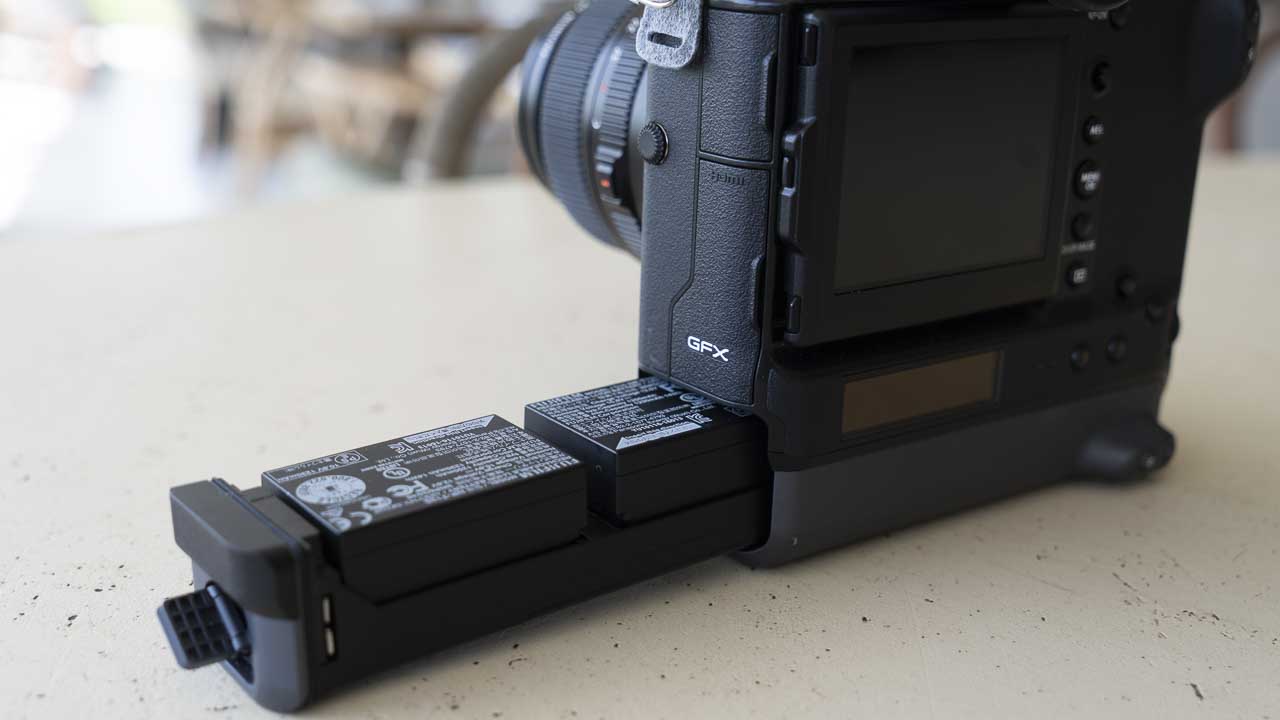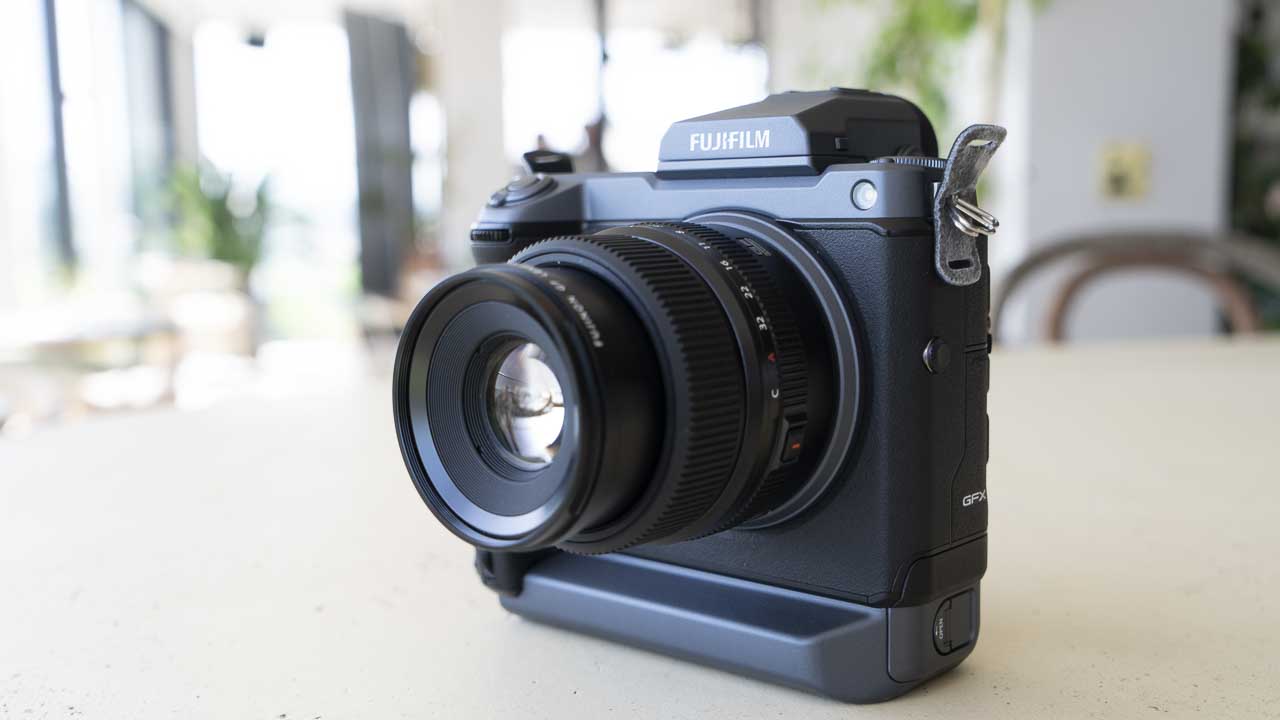Snap Verdict
I love the Fujifilm GFX 50S and 50R, but they’re not without their issues. The new Fujifilm GFX 100 builds on these cameras with more processing power, a 100Mp backside-illuminated (BSI) sensor and 5-axis in-body image stabilisation (IBIS). It’s handling isn’t perfect and the control arrangement is a departure from the traditional controls of the GFX 50S and GFX 50R, but the results are incredibly good. The colours are typically Fujifilm and the detail just keeps coming as you zoom into the image.
Key Specifications
| Price at Launch | £9,999/$9,999.95 body only |
| Sensor | 102Mp Medium format (43.8 x 32.9mm) CMOS with Bayer colour filter array |
| Lens Mount | Fujifilm G |
| AF System | Intelligent Hybrid AF (contrast AF / phase-detection AF) with up to 425 selectable AF points |
| Screen | 3-direction tilting 3.2-inch 2.36million-dot touchscreen |
| Viewfinder | 0.5-inch 5.76million-dot OLED |
| Continuous Shooting | 10fps for up to 58 Jpeg and 25 raw files with UHS-II card with the viewfinder. In Live view mode, up to 11fps with One-Shot AF or 7fps with Servo AF |
| Sensitivity | Stills: ISO 100-12,800 expandable to ISO 50-102,400, Video: ISO 200-12,800 expandable to 50-25,600 |
| Video | 4K (4096×2160) 29.97p / 25p / 24p / 23.98p 400Mbps/200Mbps/100Mbps up to Approx. 60min. |
| Storage | SD/SDHC/SDXC UHS-II |
| Connectivity | Wi-Fi, Bluetooth, USB-C, Micro-HDMI, mic, headphone, remote release, DC in, Sync terminal |
| Dimensions | 156.2mm x 163.6mm x102.9mm (inc EVF) |
| Weight | 1,400g including EVF, 2x battery & memory card |
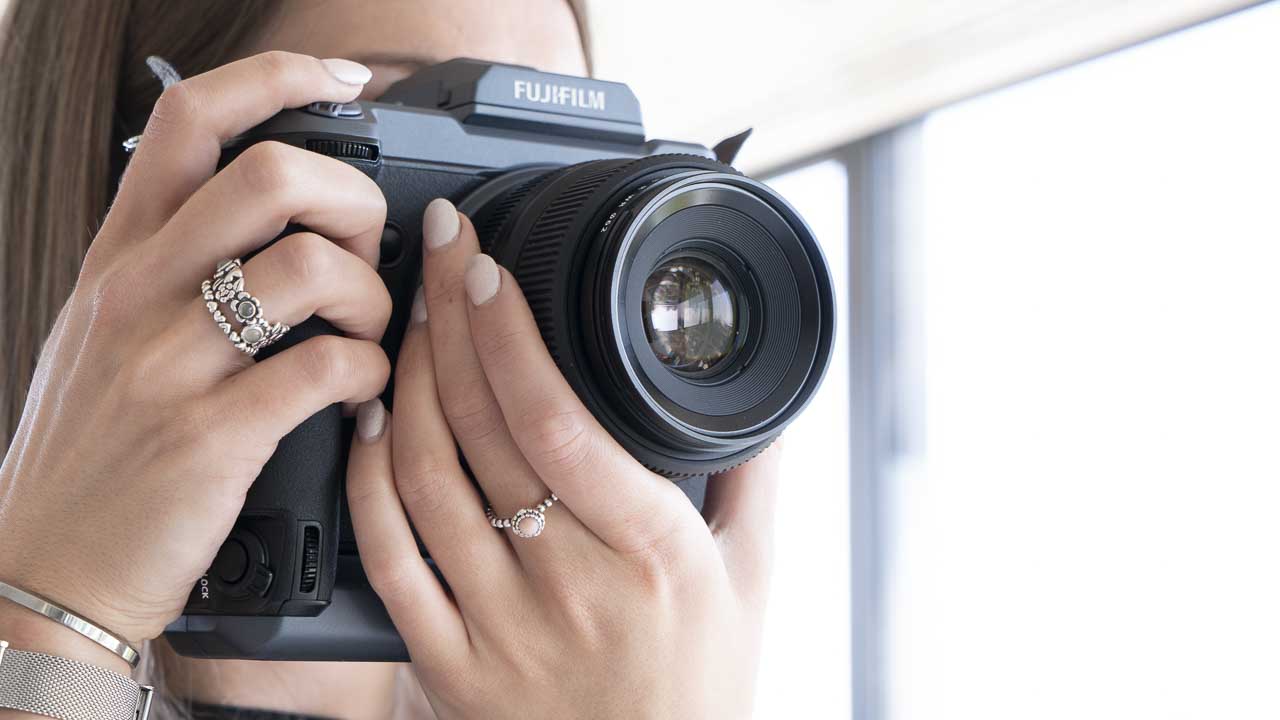
Features
The Fujifilm GFX 100 is a medium format mirrorless camera with the Fujifilm G mount. It’s also the first medium format digital camera to have in-body image stabilisation (IBIS).
Naturally, the prospect of a medium format camera with a sensor that measures 43.8×32.9mm and has 100-million effective pixels is exciting for anyone interested in capturing a lot of detail. The fact that the sensor has a backside-illuminated (BSI) design will also prick up a few years. That’s becuase it means more of the surface area is available for light gathering so there’s less signal amplification and noise.
However, the camera’s processing power is also a significant factor. And there’s good news on that front too. Fujifilm has given the GFX 100 its fourth generation X-Processor, the X-Processor 4. This has a positive impact on the camera, making it generally faster than the GFX 50S. However, Fujifilm still recommends that the electronic shutter isn’t used with moving subjects or when panning.
This increase in processing power enables the GFX 100 to shoot at up to 5fps (frames per second). Which is very good for a medium format camera with such a high resolution.
Autofocus
Although the sensor has a Bayer pattern colour filter array, it otherwise uses the same technology as the sensor in the Fujifilm X-T3. That means it has Fuji’s Intelligent Hybrid AF system that combines contrast detection with phase detection. What’s more, the phase-detection points cover virtually the whole frame and there up to 425 points available for selection.
Like Fujifilm’s X-Series cameras, the Fuji GFX 100 has Single point, Zone AF and Wide/Tracking AF options. In Single Point AF mode the focus point array can be switched between a 13×9 (117) and 25×17 (425) grid of points. There are also 6 sizes of AF point available. Similarly, in Zone AF mode the size of the zone can be changed so it covers 3×3, 5×5 or 7×7 of the 117 areas on a 13×9 grid.
Also, the customisation options that are available in cameras like the X-T3 are available on the GFX 100 in continuous autofocus (AF-C) mode.
In addition, Fujiifilm has improved the Face & Eye detection and tracking. Plus, it’s possible to switch between the detected faces to ensure the right target is used for focusing.
Thanks to the new sensor design and processor, Fujifilm is claiming a 500% improvement in the AF performance in comparison with the GFX 50S.
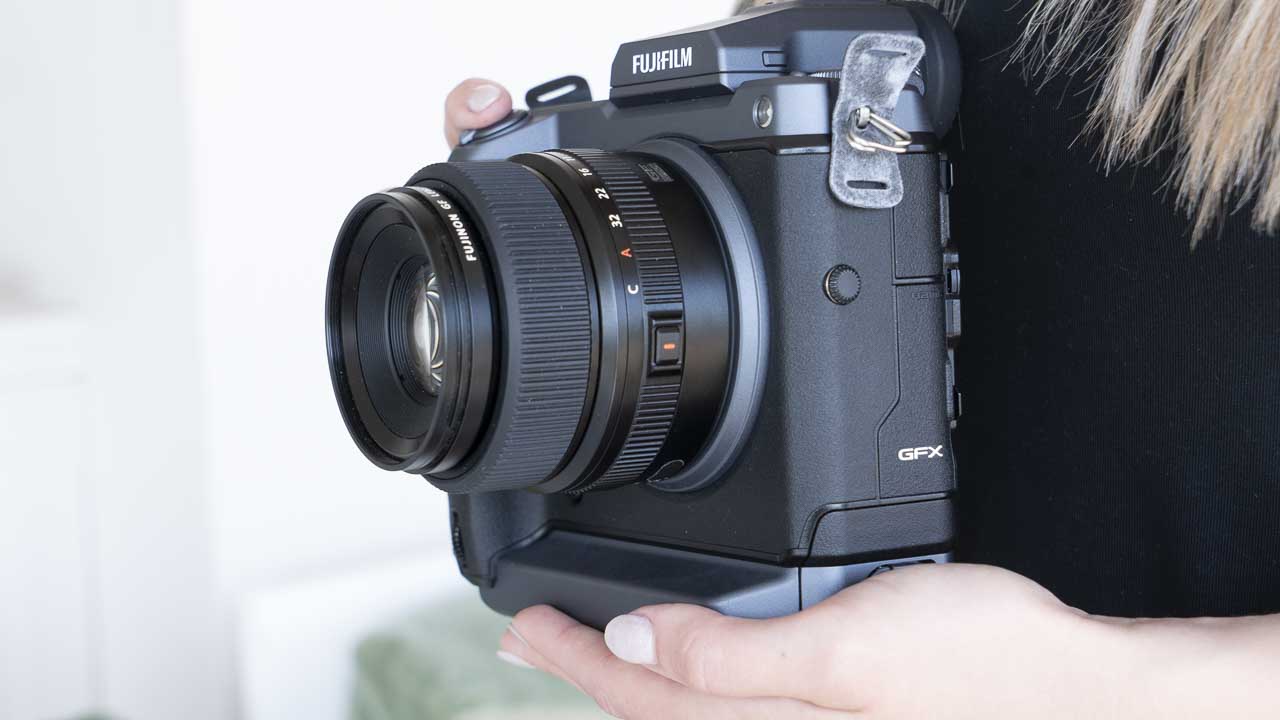
Video Specification
That extra processing power also enables a step-up in the GFX 100’s video capability in comparison with the GFX 50S. Whereas the GFX 50S maxes out at Full HD (1920×1080) video at 29.97/25/24/23.98p and 36Mbps, the GFX can shoot 4K (4096×2160) 30p video. When recording to a card there’s up to 10bit 4:2:0 colour, but when recording to an external device via the HDMI port it’s 10bit 4:2:2.
There’s a range of frame rates available, and the bit rate tops out at 400Mbps.
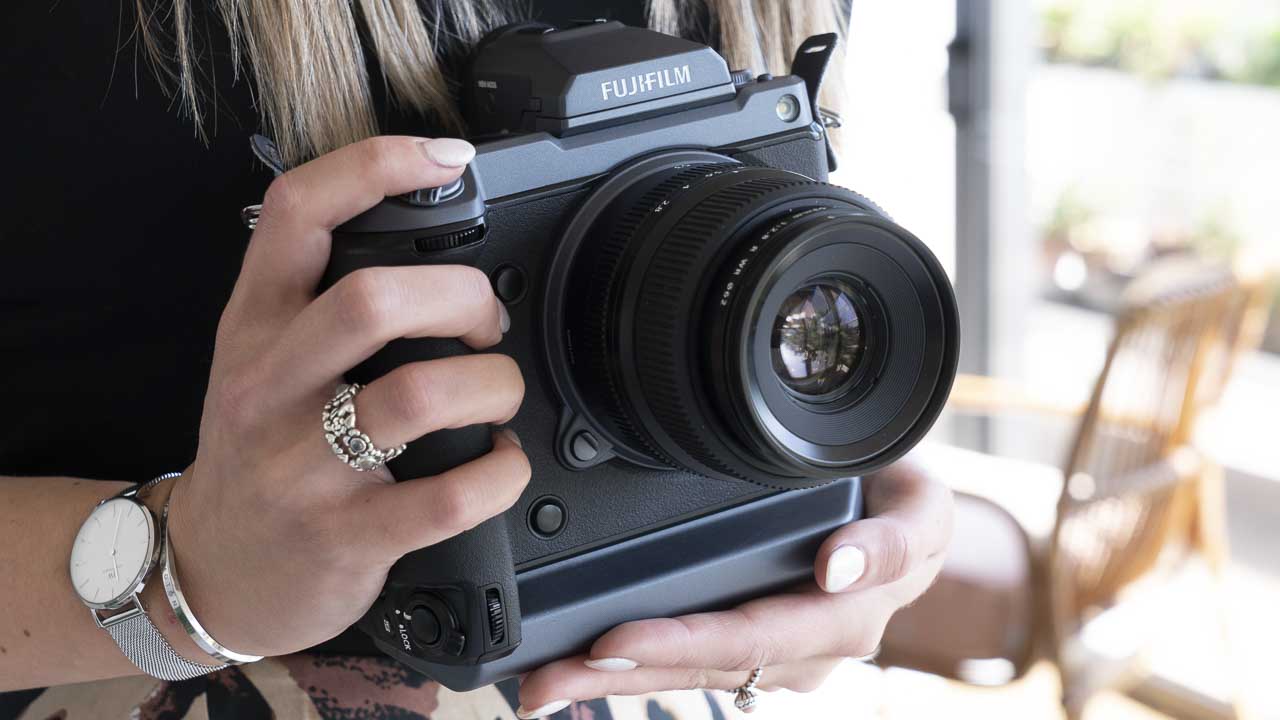
Build and Handling
As it has a 43.8 x 32.9mm sensor, the GFX 100 is always going to be bigger than an APS-C or full-frame format camera. However, including a 5-axis stabilisation system means that it’s also bigger than the Fuji GFX 50S and GFX 50R. It also prompted Fuji to add a vertical grip. This means that the Fuji GFX 100 is the first medium format mirrorless digital camera to feature an integrated double grip design.
It also means that the GFX 100 is a pretty hefty camera, weighing in at 1.4Kg with the EVF and two batteries but no lens. At one point during our testing, I carried the camera for a couple of hours without a strap, and my hand was feeling it by the end. Longer term, I used a strap.
In keeping with its flagship status, the Fuji GFX 100 is weather-sealed along 95 points, including the EVF. As well as moisture, that should keep dust at bay.
Size isn’t the only difference between the GFX 100 and the GFX 50S, GFX 50R and Fujifilm’s X-series cameras like the X-T3. For instance, the exposure control is also different because the traditional shutter speed and sensitivity dials are absent. That’s a significant shift and it’s a little puzzling.
Controls
The change to the exposure control, coupled with the lack of an exposure mode dial, initially left me a little stumped about how to set the exposure mode. Virtual shutter speed and sensitivity dials are displayed in the top LDC screen along with P, A, S or M to indicate the exposure mode, but it’s not immediately obvious how to change that mode.
After fiddling about pressing buttons and rotating dials for a while, I checked the customisation options in the menu and spotted that by default, the larger unmarked button next to the top screen changes the exposure mode. And you don’t use it in conjunction with a dial, you just press it repeatedly to toggle through the options.
While this doesn’t seem especially slick, I expect that the majority of potential GFX 100 photographers have a favourite mode that they use for the majority of the time.
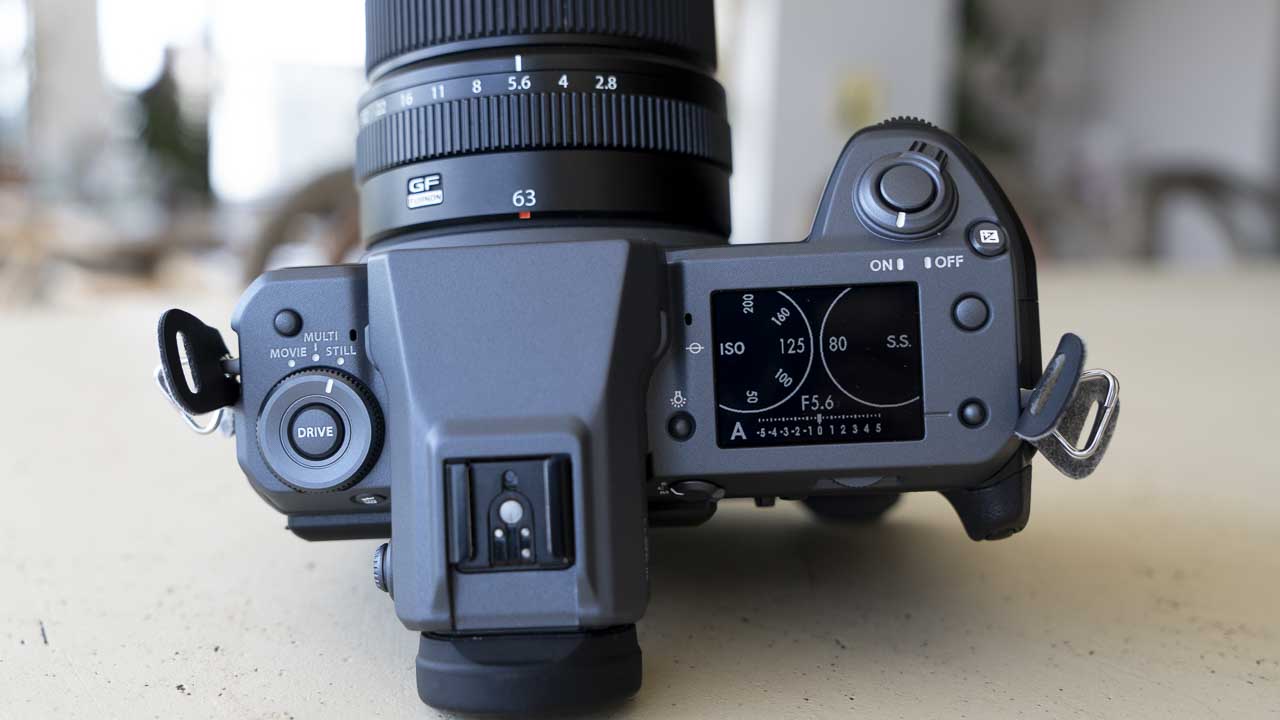
Reaching for Buttons
Even after a few hours shooting with the Fuji GFX 100, I found my index finger falling on the exposure mode button when I was reaching for the exposure compensation button. That button is actually on the edge of the top-plate, close to the shutter release. I find it quite hard to locate when I’m looking in the viewfinder.
Consequently, I used the custom controls to swap the purpose of these two buttons. This put an end to me accidentally changing the exposure mode and let me set the exposure compensation value quicker. I would prefer an exposure compensation dial though.
Pressing the third button on the right of the GFX 100’s top-plate toggles through the display options for the top-screen. I mainly used the virtual dial view, but there’s also an information view and a histogram view.
Exposure Control
As the GFX 100 uses Fujifilm’s G lenses, which have an aperture ring, the aperture is set in the traditional way. Shutter speed and sensitivity are adjusted using the front and rear control dials. As I’ve alluded to, the exposure compensation is adjusted by pressing a button while rotating a control dial. While this is fairly standard in photography, it’s a change from Fujifilm’s other GFX and X-Series cameras. I think it’s strange that Fujifilm should make this move for it’s most advanced medium format camera to date. If I was looking to upgrade from the GFX 50S, or use it interchangeably, it might put me off.
I’d prefer it is the GFX 100 had sensitivity (ISO), shutter speed and exposure compensation dials. And maybe a drive mode dial as well.
Double Grips
Including the IBIS unit in the GFX 100 necessitates a few changes in the cameras’ build in comparison with the GFX 50S. One of these sees the battery moved to the bottom of the camera and the logical step was to add a second alongside it to create a vertical grip.
Although the two grips have the same controls on them, they feel very different. The horizontal grip is ergonomically shaped and covered with a textured coating. Meanwhile, the vertical grip is much more angular and lacks a grippy covering.
The vertical grip is also thinner than the horizontal grip. I find I have to stretch my hand to wrap my fingers around the horizontal grip. This means the vertical grip is easier in this respect, but it doesn’t feel nearly so secure or comfortable in my hand.
While I don’t like the shape or the lack of purchase of the vertical grip, it’s easier to locate the two buttons behind its shutter release than it is on the horizontal grip when you’re looking in the viewfinder. Consequently, I didn’t feel the need to swap their function like I did on the horizontal grip. However, it makes sense to do so to mirror the control arrangement.
I have a minor issue with the battery compartment lock. It tends to flap away from the body. It didn’t get suffifiently snagged on anything to cause the door to open, but it’s annoying.
Viewfinder
Fuji has given the GFX 100 a 0.5-inch OLED electronic viewfinder (EVF) with 5.76million dots. So it’s one of the best-specified viewfinders around. But it doesn’t just score on the numbers front, it’s also great to use. It’s nice and big with lots of detail visible.
I experimented with setting the power management option to Boost and ‘EVF Resolution Priority’ and although it makes the details look a bit sharper than when it’s set to ‘EVF Frame Rate Priority’, the difference is only slight. Consequently, I stuck with EVF Frame Rate Priority as it makes the viewfinder more responsive with less moire patterning visible when the scene includes very fine repeating patterns.
Like the GFX 50S, the GFX 100’s EVF is mountable via Fujifilm’s EVF-TL1 tilt adapter. This enables the viewfinder to swivel left or right by 45°, or tilt up/down through 90°. That’s pretty neat for shooting at awkward angles.

Screen
Unusually, the Fuji GFX 100 has three screens. In addition to the small screen on the top-plate there’s a 3.2-inch 2.36million-dot touchscreen on its rear, plus a slim screen beneath it.
The large screen has a dual tilting mechanism that allows it to tip down or up horizontally or flipped-up for vertical orientation shooting. That makes it useful for shooting portrait and landscape orientation images.
This screen is also touch-sensitive. What’s more, it’s compatible with gesture control. When this is activated you can swipe up, down, left or right to access key features such as the histogram view, Film Simulation modes, white balance options and electronic level. Naturally, you can customise which features are accessed this way.
However, your nose, or a stray knuckle can also change the settings if it touches the screen.
You can also opt to use the screen (or part of it) to set the AF point while you look in the viewfinder. This is a nice option, and the screen is effective, but I generally prefer to use the joysticks on the back of the camera.
Performance
Just chimping the first few shots from the GFX 100 is enough to tell you that it’s very capable. It’s well worth checking out if you’re contemplating purchasing a medium format camera. It’s not quite a snappy as a small format camera, but it’s not far behind and the results are incredible.
At 300ppi, the Fuji GFX 100 produces 98.62 x 73.96cm or 38.8 x 29.1-inch images. That’s huge. So while it’s always tempting to pixel-peep, it doesn’t give a realistic view of what the images will look like in normal use. You may not always need to make such big prints or dramatic crops.
The larger than average sensor also brings the ability to limit depth of field. And this, combined with super-sharp detail, makes for some very attractive images.
The colour and contrast from the GFX 100 is just what you’d expect from a high-end Fujifilm camera – lovely. Everyone has their favourite Film Simulation mode and they do a terrific job of creating print/share-ready images in-camera.
Image Quality
The GFX 100 produces some of the best results I’ve ever seen at ISO 102,400. There’s still lots of noise visible in the deeper shadows, but there’s a reasonable amount of detail visible. And if you’re limiting the size of a print to A3, or viewing on a 27-inch iMac, you’re likley to be fairly impressed.
However, few people would pay £9,999/$9,999.95 for a medium format camera with the intention of using it at its highest sensitivity setting. The lower ISO settings are far more likely to be used. Afterall, in many situations, if there’ isn’t enough light to capture a low ISO image, you can use flash.
Inevitably, it’s best to keep to the native sensitivity range of ISO 100-12,800. I’d actually aim for ISO 6,400 as a maximum, the noise level at 100% is remarkably low.
Autofocus Performance
I am impressed by the autofocs performance. Firstly, the camera gets subjects sharp quickly. It’s not quite as fast as the X-T3 (that uses smaller, lighter lens elements), but I think it’s the fastest medium format AF system I’ve used to date. In addition, the Eye AF does a decent job of recognising eyes and focuysing on them. However, I find hats and/or spectacles confuse it.
It also copes well with quite low light and low contrast. I was pleasantly surprised by some of the subjects that the GFX 100 was able to focus on.
Traditionally, medium format cameras have very clunky and slow autofocus systems. I’m not saying that the Fuji GFX 100 is going to be used at football matches, but as the image below demonstrates, its AF is way better than the average medium format camera’s. I shot the same subject in Single AF mode and zooming into the shots revealed that subject aren’t completely sharp. In Continuous AF mode, however, it nailed them.
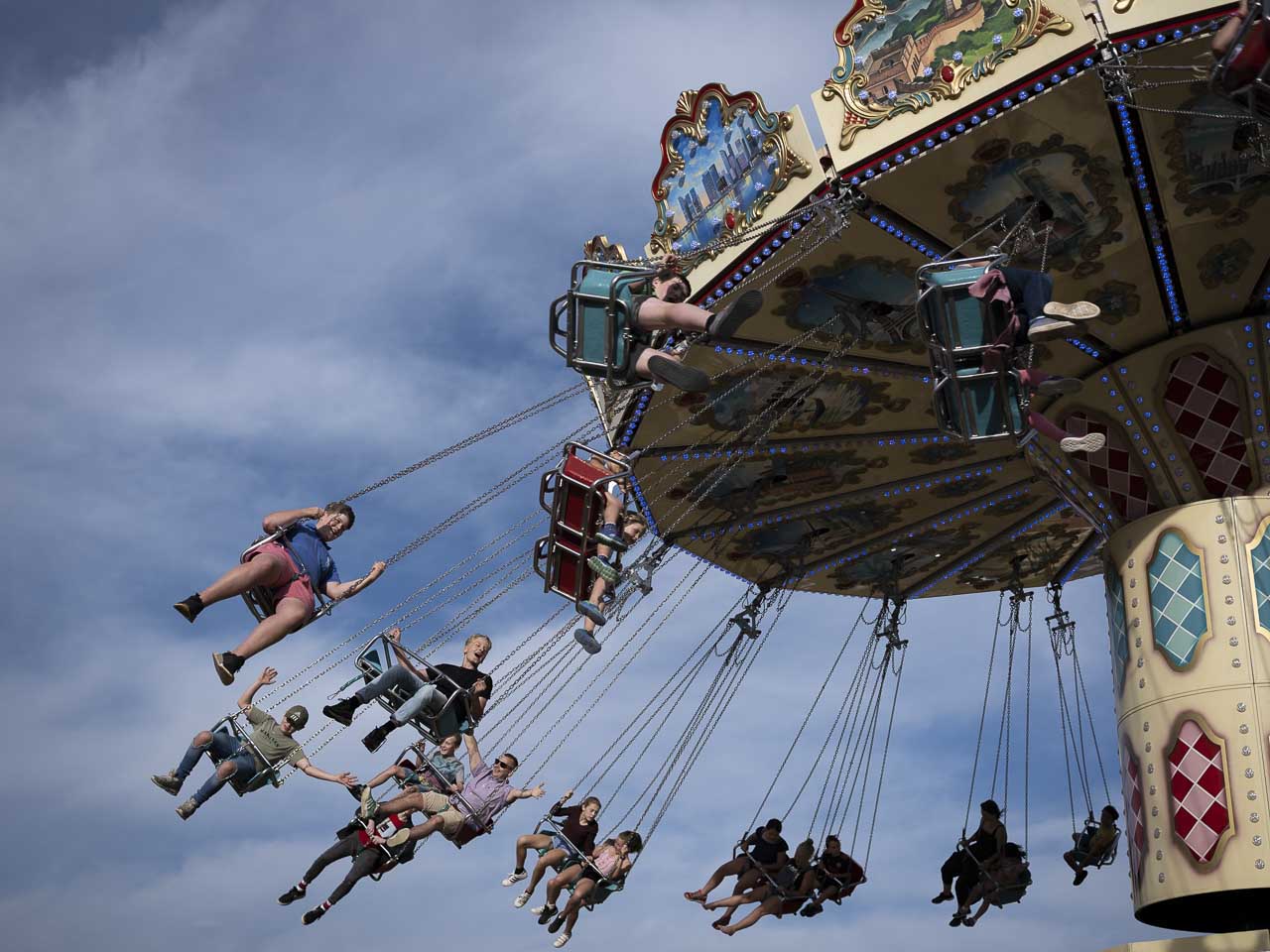
Exposure and Dynamic Range
As the GFX 100 has an electronic viewfinder that shows the final image accurately, I found the Multi or Average metering settings fine for the vast majority of shooting situations. There were quite a few occasions when I reduced the exposure by 1/3Ev to protect the highlights or increase saturation, but that’s not a drama when you know what you’re getting.
Despite the high pixel count, the medium format BSI sensor still enables the GFX 100 to capture a huge range of tones. That means there’s plenty of scope to brighten underexposed images or shadows if you need to. The low ISO images can be pushed by over 4EV without the shadows becoming excessively noisy or having colour problems.
Stabilisation
The Fujifilm GFX 100 uses a three-axis accelerometer, three-axis gyro sensor and a dedicated dual processor to power its in-body image stabilisation (IBIS). This gives stabilisation across 5-axis with up to 5.5EV of shutter speed compensation when hand-holding the camera.
I was able to achieve a hit rate of approximately 40% at a shutter speed of 1/8sec and nearly 100% at 1/15sec when I used the GFX 100 with its mechanical shutter and the GF 63mm f/2.8 R WR lens.
Sample Images
Follow the link to browse and download full-resolution images
[FAG id=83770]
Sample Video
The video below was shot on the Fujifilm GFX 100 set to 4K (3840×2160) 25p, 400Mbps, H.264 and Long GOP in the Standard Film Simulation mode. The audio was recorded using the onboard mic and it was quite windy so there’s some wind noise.
Verdict
I’m not completely sold on Fuji’s switch away from traditional exposure controls. They have been a big selling point for its X-Series cameras and I think it’s very strange to move from that for its flagship model. The dual dial control mechanism isn’t unusual, it’s very common, and that means it’s probably not a major problem for most people. But I can’t understand why Fujifilm has moved away from what many photographers love about its cameras.
It would’ve been nice if the virtual dials could be adjusted by touch, but the top screen isn’t touch-sensitive.
I’m also a little perplexed by the GFX 100’s vertical grip. It’s not even slightly ergonomically shaped, it’s like holding a Toblerone box, and it needs a coating to give more purchase.
However, as soon as I started shooting with the GFX 100, I fell in love with the images. They’re superb. The level of detail is outstanding and noise is controlled extremely well. Add in Fujifilm’s understanding of colour and I can forgive the strange handling decisions.
In the UK, the Fujifilm GFX 100 is available for to order from Wex Photo Video and Park Cameras. In the US, you’ll find it at BH Photo Video, Adorama and Amazon.com
Against the Competition
I was able to use the Fujifilm GFX 100 just a few days after using the Hasselblad X1d II 50C and while testing the Phase One XF IQ4 150MP. They’re all medium format cameras, but they’re very different from one another.
Of the three, I think the GFX 100 has the fastest, most versatile and most reliable AF system. It’s a bit of a beast in comparison to the Hasselblad X1D II 50C, but it’s positively sylphlike compared to the Phase One DSLR. And apart from its size, it’s also the camera that comes closest to handling like an APS-C or full-frame format camera. It’s pretty fast and agile.
The Phase One XF IQ4 150MP produces incredible images, but it really makes you work for them. It’s crazily heavy and the AF system, which has a single point seems very dated in comparison with the Fuji GFX 100’s. At £9,999/$9,999.95 body only, the GFX 100 is beyond most photographer’s price range. But the Phase One XF IQ4 150MP retails for £40,800/$51,990 with a lens. If I had that kind of money to spend on a camera system, I’d probably by two GFX 100’s, a couple of lenses and a campervan to transport them in.




